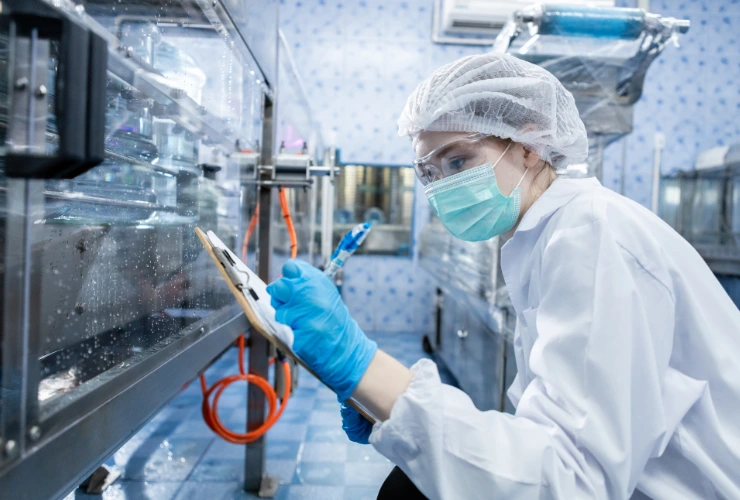Upstream and downstream bioprocessing are two essential stages in the development and manufacturing of bioproducts, from enzymes to therapeutic proteins. This article explores what each phase involves, how they differ, and why understanding both is crucial to achieving efficiency, scalability and product quality in biomanufacturing. At Cultiply, we integrate upstream and downstream strategies to optimise microbial processes across sectors such as agriculture, pharma and food. Here’s how both stages work—and how they complement each other in practice.

What is upstream bioprocessing and why is it important?
Upstream bioprocessing is the foundation of any biological manufacturing process. It refers to the initial phase where cells—whether microbial or mammalian—are cultivated under controlled conditions to produce the desired biological material. At Cultiply, we specialise in microbial bioprocessing, often using bacteria or yeast strains to generate enzymes, probiotics or other functional compounds at scale.
This stage involves a series of coordinated steps designed to support optimal cell growth and productivity:
- Media preparation: Formulating nutrient-rich environments tailored to the specific microorganism.
- Inoculum development: Reviving and expanding cells from a master cell bank under sterile conditions.
- Bioreactor cultivation: Scaling up cell density in fermenters with precise control of pH, temperature, oxygen and agitation.
- Monitoring and optimisation: Adjusting parameters in real time to maximise product yield and consistency.
Why does upstream matter so much? Because everything that follows—purification, concentration, formulation—depends on the quality and volume of biomass generated here. For example, in the production of biofertilisers, a high-density culture of beneficial bacteria ensures effective downstream separation and formulation.
Another key consideration is process mode. Fed-batch cultivation, for instance, is widely used for its robustness, while perfusion (continuous upstream processing) offers higher productivity and faster turnaround—especially relevant in pharma and biotech.
In short, upstream bioprocessing lays the groundwork. Its success determines not only product quantity, but also structural characteristics like protein folding or glycosylation, especially critical in biologics. At Cultiply, we design upstream strategies tailored to each client’s goals, microorganism and industry requirements.
What does downstream bioprocessing involve and what is its purpose?
Downstream bioprocessing begins once the biomass or fermentation broth is ready. Its primary goal is to recover, purify and refine the desired product—be it an enzyme, organic acid, therapeutic molecule or live microbial culture. This phase is where raw biological material becomes a high-quality, application-ready product.
The downstream process typically involves:
- Cell separation and clarification: Removing cells and debris from the culture using centrifugation or filtration.
- Product isolation: Extracting the target compound, often using techniques like solvent extraction or ultrafiltration.
- Purification: Increasing purity through chromatography (e.g., ion exchange, affinity) or precipitation.
- Polishing and concentration: Final refinement to ensure consistency, stability and compliance with specifications.
In microbial processes, downstream can be particularly challenging due to complex media, high viscosity or the presence of multiple by-products. For example, extracting a heat-sensitive enzyme from bacterial culture requires precise temperature control and rapid processing to maintain activity.
This stage is also where cost and yield are most sensitive. Losses during purification or poor recovery rates can undermine even the most productive upstream process. That’s why integration is key: at Cultiply, we optimise upstream parameters—like expression level or cell lysis behaviour—to make downstream simpler, faster and more efficient.
Beyond purification, downstream processing often includes formulation and stabilisation, especially for products like probiotics or liquid bioinputs, which must retain viability during storage and transport.
Ultimately, downstream bioprocessing is about adding value through precision. It transforms a complex mixture into a clean, stable, and marketable solution—ready to meet the demands of pharma, agriculture or food production with reliability and quality.

Upstream vs downstream: what are the main differences?
Although upstream and downstream bioprocessing are complementary, each stage has distinct goals, methods and challenges. Upstream focuses on growing microorganisms or cells under optimal conditions to generate the target product. Downstream, in contrast, is about isolating and purifying that product from the complex mixture generated during fermentation.
Understanding these differences helps identify where efficiencies can be gained, whether in bioreactor design, media formulation or purification strategies. Here’s a comparative overview:
| Feature | Upstream Bioprocessing | Downstream Bioprocessing |
| Main goal | Grow cells and produce target biomolecules | Recover, purify and stabilise the final product |
| Typical techniques | Fermentation, media optimisation, cell culture | Filtration, centrifugation, chromatography |
| Equipment | Bioreactors, incubators, sensors | Separators, ultrafilters, purification columns |
| Outputs | Biomass or culture broth | Purified proteins, enzymes, microbial products |
| Main challenges | Cell growth rate, contamination control | Yield loss, purity, scalability of purification |
Both stages require coordination to ensure a smooth and cost-effective process—particularly in microbial systems where variables can shift rapidly.

Why understanding both stages is essential in microbial bioprocessing
In microbial bioprocessing, upstream and downstream are not isolated phases—they’re deeply interdependent. A well-optimised upstream process doesn’t just boost productivity; it simplifies purification, reduces waste, and enhances consistency in the final product. Conversely, downstream constraints can influence how upstream strategies are designed from the outset.
For example, if a fermentation yields a product prone to degradation, downstream teams may request process changes like reduced temperature cultivation or modified harvest timing. Similarly, upstream adjustments—such as tweaking carbon sources or induction timing—can dramatically affect the ease of purification later.
This is particularly relevant in sectors like biofertilisers, where live microbial cultures must be both concentrated and viable post-purification. Or in industrial enzyme production, where host strain selection impacts downstream filtration rates and purity levels.
At Cultiply, our integrated approach bridges both stages from day one. We develop upstream solutions that not only maximise titre, but also anticipate downstream bottlenecks—because producing more is only useful if you can recover it efficiently.
Understanding the full bioprocess is about more than operational excellence; it’s about enabling sustainable, scalable and high-quality production—whether for agriculture, food tech or pharmaceutical applications.
How to optimise upstream and downstream processes
To optimise bioprocessing, upstream and downstream must be treated as a unified system. That means selecting the right microorganism, fine-tuning culture conditions, and aligning product expression with downstream capabilities. At Cultiply, we design bioprocesses that grow with your needs—whether you’re scaling from lab to pilot, or refining purification for market launch. By coordinating both stages, we reduce costs, minimise losses and ensure quality across the entire production chain. Ready to optimise your microbial bioprocess? Let’s talk.















